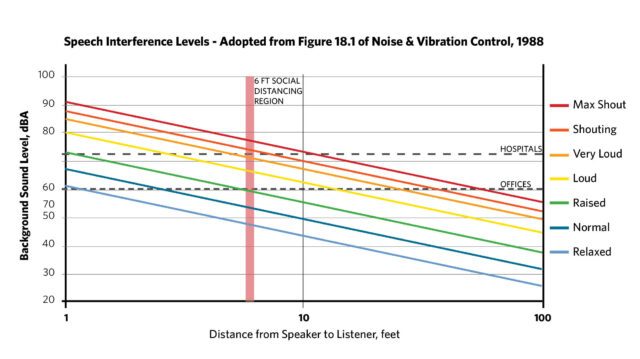Michael Bahtiarian
Energy, Environmental, Transportation |
Market Leader
Principal

Being able to communicate with co-workers and clients especially at job sites just got a lot harder these past six months. The need to wear a face mask and stay six feet apart are both detractors to accurately hearing what others are saying. Add to the mix a higher than usual level of background sound, and you have a recipe for failed communication. This may be worse than talking on your cell phone with only one bar!
My colleague Alex Odom’s blog, “Communication in Crisis” discussed the limitations on Speech Intelligibility for people wearing face masks, especially N95’s. Whether it is the high performance N95 or even a simple bandana, a face covering removes many visual cues the other person receives during face-to-face communication. Likewise, there is some reduction of sound, although Alex pointed to research that suggested it was very little.
The term Speech Intelligibility (or just Intelligibility) is the clarity or accuracy of a listener to comprehend a speaker’s words. It is expressed as the percent of accurately understood random words spoken during a test sequence. Intelligibility is just one of many metrics used to define clarity of spoken words.
Another metric used to gauge the effectiveness of personal communications is the Speech Interference Level (SIL). This metric was standardized by the Acoustical Society of America (ASA) back in 1977 (see American National Standard S3.14-1977). This is much different from Intelligibility, as SIL is the sound level expressed in decibels at which a certain vocal level is required for basic communications. That vocal effort is a function of the distance between the speaker and the listener and the background sound level expressed in dB-SIL.
Development of curves that relate SIL, distance and vocal effort were the result of work by Beranek (1947) and Lazarus (1987). Beranek’s influential text, Noise & Vibration Control (1988) includes a graph of SIL derived from an average male and female voices (see Figure 18.1 in the text). I know that measurement of SIL is not easy for our readers, so we have converted the original graph from SIL to dBA (assuming a flat spectrum). With this assumption the overall A-weighted sound pressure level in dBA is 7 decibels higher than the Speech Interference Level in dB-SIL. We also changed the distances from meters to feet.

Figure 1 is our updated graph and it shows that, at a distance of 6 feet, communication in a normal voice can occur up to background sound level of 53 dBA. At a level of 65 dBA you will need to use a loud voice to communicate at a distance of 6 feet and at 77 dBA you will need to shout at the top of your lungs. Looking at it another way, if you wanted to speak normally in a 65 dBA sound environment you would need to cut the distance to the other person to less than one foot and severely circumvent the social distancing requirement.
Not only does this present difficulty on construction sites, where communication is critical for safety, it also causes challenges in areas such as factories, noisy conference rooms (something I just experienced at a local organization’s board meeting), and especially hospitals. In his blog, Alex describes the changes in background noise levels in hospitals, stating that they’ve increased from 57 dBA in 1960 to 72 dBA today during the daytime hours. For nurses, doctors, and other healthcare professionals to accurately communicate with each other and their patients, while maintaining even a distance of 4 to 6 feet, they might need to speak very loudly, nearing a shout. Combined with the disadvantage of minimal visual cues, communicating effectively in an environment such as this for any length of time will be taxing.
Even a typical office setting has its challenges. A reasonable background noise level for open offices is around 60 dBA. With 6 feet of distance between you and your coworkers, raised voices and potentially even greater vocal effort may be needed for just your run of the mill conversation. Maintaining this for a significant length of time can cause strain and discomfort.
In this era of social distancing, with speakers donning masks and maintaining social distancing, communication is as important as ever, with new hurdles to consider. Many of the necessary facial coverings and safety precautions negate visual cues, putting strain on intelligibility and causing significant difficulties on speech in crucial environments. So the next time you’re having an important conversation, heavily consider the relevant background noise level, and speak up accordingly to maintain effective communication.
I would like to thank my Acentech colleague, Ethan Casavant for his contributions to the blog text and especially for helping recreate the Beranek SIL chart above.